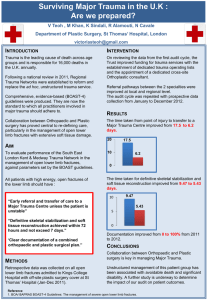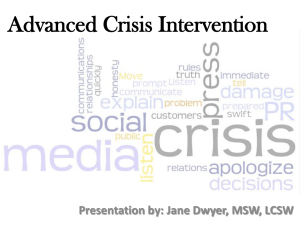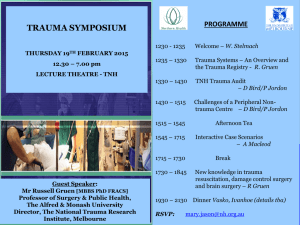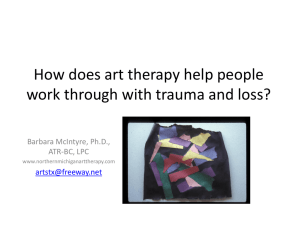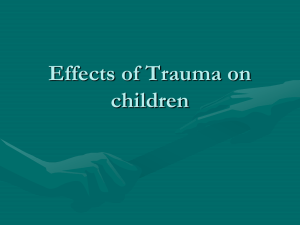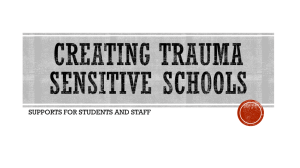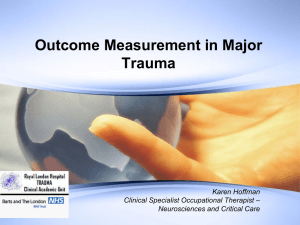Geriatric Trauma
advertisement
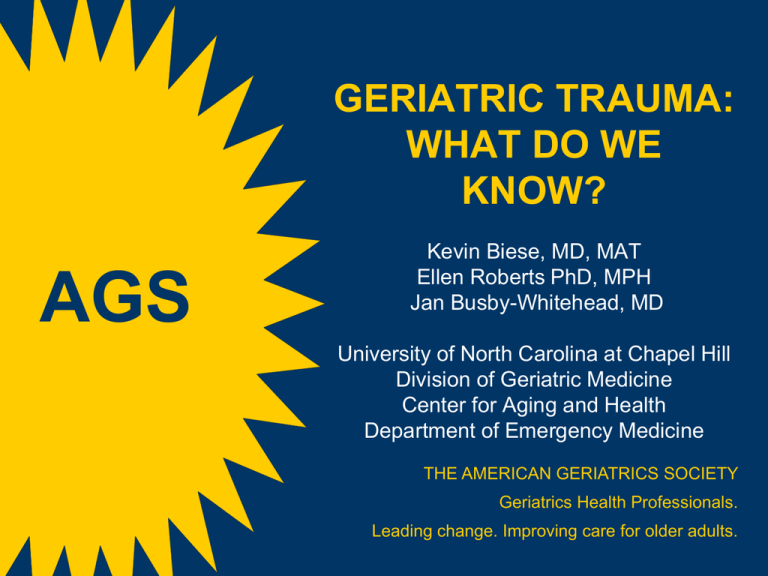
GERIATRIC TRAUMA: WHAT DO WE KNOW? AGS Kevin Biese, MD, MAT Ellen Roberts PhD, MPH Jan Busby-Whitehead, MD University of North Carolina at Chapel Hill Division of Geriatric Medicine Center for Aging and Health Department of Emergency Medicine THE AMERICAN GERIATRICS SOCIETY Geriatrics Health Professionals. Leading change. Improving care for older adults. LEARNING OBJECTIVES • Describe the unique presentations of geriatric trauma • Identify areas of particular risk for elderly patients with traumatic injuries • Suggest care process changes that may improve the care of geriatric trauma patients Slide 2 GERIATRIC TRAUMA: OUTLINE • The basics • Rib fractures • Pelvic fractures • Head trauma • Warfarin • C-spine fractures • Triage Slide 3 GERIATRIC TRAUMA: DISCLAIMERS • Most studies are retrospective reviews • No standard definition of “geriatric” or “elderly” Slide 4 GERIATRIC TRAUMA: EPIDEMIOLOGY • Elderly are growing in numbers • Patients ≥65 years account for 10% of all traumas, but 28% of deaths! • Trauma is the 7th leading cause of death in elderly Slide 5 GERIATRIC TRAUMA: MECHANISMS • Falls — most common Balance, strength, vision • Motor vehicle collision (MVC) — most fatal Judgment, vision, reaction times decreased Crash fatality rates are much higher • Burns — 1/5 of all burn unit admissions Mortality estimate = age + % burn Slide 6 GERIATRIC TRAUMA: COMPLICATING FACTORS • Past medical history Cardiac and pulmonary disease limit physiological response to stressors Vital signs are difficult to interpret • Medications Anticoagulants Beta blockers • Cause of the event Myocardial infarction, syncope, stroke, hypoglycemia Slide 7 CASE 1: INTRODUCTION • 71-year-old woman restrained driver in MVC • “T-boned” on passenger side • Unknown rate of speed • No airbag deployment • Prolonged extrication • Not ambulatory at scene • EMS: systolic blood pressure (SBP) 100, HR 80, oxygen saturation 100% on non-re-breather mask Slide 8 CASE 1: ADDITIONAL INFORMATION • Patient is complaining of shortness of breath, left chest wall pain, and left clavicle pain • She hit her head with reported loss of consciousness • Patient denies neck or back pain • No nausea or abdominal pain • Yellow trauma alert — no trauma team activation Slide 9 CASE 1: PRIMARY SURVEY • A Patient speaking in complete sentences • B Clear bilaterally, but diminished effort; significant bruising/pain left chest wall • C Good pulses 4, 2 IVs in place • D Glasgow Coma Scale (GCS) 14, moving all 4 extremities • E Patient exposed, warm blankets placed Slide 10 CASE 1: SECONDARY SURVEY • Vital signs: 103/51, 80, 18, 36.3 F, 100% NRB • General: Dyspneic, awake and alert • HEENT: 3-cm laceration on left side of scalp, PERRLA • Chest: Bruising left clavicle/left chest wall with tenderness • CV: RRR with HR 80 • Abdomen: No bruising, soft, non-tender, non-distended • Pelvis stable • Neurologically intact Slide 11 CASE 1: PAST MEDICAL HISTORY • Hypertension • Osteoporosis • “Non-cardiac chest pain” • Medications: Hydrochlorothiazide Alendronate (Fosamax) • Allergies: Penicillin Slide 12 CASE 1: CHEST X-RAY Slide 13 CASE 1: PELVIS X-RAY Slide 14 CASE 1: CHEST CT Left 1, 3, 4, 5, 6 rib fractures, left scapular fracture, left clavicle fracture, small pneumothorax Slide 15 CASE 1: LAB RESULTS • Hematocrit — 36 • Potassium — 2.9 • Creatinine — 1.0 • INR — 1.0 Slide 16 CASE 1: HOSPITAL COURSE • Day 1 – Admitted to surgical ICU, L chest tube placed • Day 2 – Rapid atrial fibrillation, amiodarone drip with conversion to sinus rhythm • Day 5 – Chest tube pulled • Day 7 – Hypoxic, hypotensive, rapid atrial fibrillation, left pleural effusion, intubated • Day 8 – Left chest tube replaced • Day 12 – Chest tube removed • Day 22 – D/C to home • 5 months later – Doing well Yellow trauma — 22-day hospital stay! Slide 17 RIB FRACTURES IN THE ELDERLY (1 of 2) • Prospective cohort of 405 patients admitted with rib fractures from blunt trauma • 113 patients > 65 years old • Elderly had much higher mortality (20% vs. 9%) • Isolated thoracic trauma 75% of elderly patients sustained this by fall from standing Mortality 15% if age >65; 0% if <65 Pneumonia 34% if age >65; 11% if <65 • Most geriatric deaths occurred >72 hours after trauma and resulted from sepsis or respiratory failure Bergeron E, et al. J Trauma. 2003;54:478-485. Slide 18 RIB FRACTURES IN THE ELDERLY (2 of 2) Age (years) 3-6 rib fractures >6 rib fractures <65 ≅10% ≅25% ≥65 ≅30% >60% If >65 with 3 or more rib fractures, admit; if >6 rib fractures, ICU Bergeron. J of Trauma 2003; 54: 478-85. PELVIC FRACTURES IN THE ELDERLY (1 of 2) • Usually associated with falls from standing & MVCs • Higher percentage of lateral compression fractures than in younger patients Fewer “severe” fracture patterns • High rates of hemorrhage, transfusion, and ICU admission, even with “benign” fracture patterns Slide 20 PELVIC FRACTURES IN THE ELDERLY (2 of 2) • 92 consecutive blunt trauma pelvic fracture patients received angiographic embolization (AE) for “liberal indications”: Hemodynamically labile, concerning fracture pattern (open book, vertical shear, butterfly), or pelvic hematoma on CT • Patients >60 years (n=17) were compared with younger patients No difference in injury severity score, pelvic fracture pattern, SBP, or blood requirement >60 years: 94% chance of active bleed vs. 52% in younger patients • Consider AE before hemodynamic collapse in elderly patients with significant pelvic fractures Kimbrell. Arch Surg. 2004. Slide 21 CASE 2 • 90-year-old woman presents 3 days after fall in bathroom, when she hit her head on toilet • No symptoms for 2 days • This morning, mild headache and face pain • Medications: warfarin, oxycodone, amitriptyline Slide 22 HEAD TRAUMA IN ELDERLY • Bridging veins travel further • More space for hematoma collection before symptoms • Age >65 have 30%85% mortality with intracranial hemorrhage (ICH) 25 higher than younger patients with matched injuries • Considered high-risk in brain imaging protocols (New Orleans, Canadian) Webmm.ahrq.gov, retrieved June 3, 2011. Slide 23 WARFARIN AND ICH IN ELDERLY • 9% of elderly patients with traumatic brain injury are on warfarin • Risk of spontaneous ICH on warfarin is 0.35.4% • Blunt head trauma on warfarin with minimal or no symptoms, 7%14% have ICH • Patients frequently have supra-therapeutic INR 11% have INR >5 • Beware delayed acute subdural hematoma (DASH) — consider admission for observation even if head CT is negative • Check INR Slide 24 AGGRESSIVE COUMADIN PROTOCOL (1 of 2) • Emergency department initiated new protocol for patients with suspected head trauma on warfarin Immediate evaluation Immediate head CT Type & cross match Thaw 2 units AB FFP • If positive head CT Transfuse FFP, Vitamin K IV, neurosurgery evaluation • If negative head CT Admit for observation Ivascu FA, et al. J Trauma. 2005;59:1131-1139. Slide 25 AGGRESSIVE COUMADIN PROTOCOL (2 of 2) • 82 patients, 19 with ICH • Time to initiate warfarin reversal dropped from 4.3 hours pre-protocol to 1.9 hours • Mortality dropped from 48% to 10% Ivascu FA, et al. J Trauma. 2005;59:1131-1139. Slide 26 CASE 3 • A 97-year-old woman fell while getting out of bed • Normal activity throughout day; eventually presents with moderate neck pain • No neurological deficits on exam Slide 27 GERIATRIC C-SPINE FRACTURES Type II odontoid fractures are the most common LearningRadiology.com, retrieved June 3, 2011. Slide 28 ODONTOID FRACTURES Insert image/ diagram of 3 types of odontoid fractures. GERIATRIC C-SPINE FRACTURES • Blunt trauma victims >65 years are 2 more likely than younger patients to have C-spine fractures • Odontoid fractures: 20% of elderly C-spine fractures vs. 5% in younger patients • Debate in literature about management of types II, III odontoid fractures • Patients >65 years included in NEXUS, identified as high risk in Canadian C-Spine Rule • X-rays frequently inadequate • Have a low threshold to use CT on geriatric C-spine Touger. Ann Emerg Med. 2002. Slide 30 TRIAGE • Elderly trauma patients are under-triaged, in violation of paramedic protocols • Should the elderly be triaged more aggressively? Slide 31 CRITERIA FOR TRAUMA TEAM ACTIVATION (TTA) (1 of 3) • Review of Trauma Registry at UCLA and LA County from 19932000 • Included admitted trauma patients age >70, except interhospital transfers, ground-level falls, subacute subdurals • 25% met TTA criteria: SBP <90 or Pulse >120 RR <10 or >29 Unresponsive to pain Gunshot wound to trunk • 883 patients included Demetriades D, et al. J Trauma. 2001;51:754-756. Slide 32 CRITERIA FOR TRAUMA TEAM ACTIVATION (TTA) (2 of 3) 90% 80% 85.70% TTA Non- TTA 67.20% 70% 62.50% 60% • 63% of patients with severe injuries did not meet standard TTA criteria 50% 39.40% 40% 30% • Among all patients who did not meet criteria, mortality was 16% 25.50% 20% 10% 5.50% 0% ISS <15 ISS 16-29 ISS 30+ ISS = Injury Severity Score • Include age 70 years as TTA criterion? Demetriades D, et al. J Trauma. 2001;51:754-756. Slide 33 CRITERIA FOR TRAUMA TEAM ACTIVATION (TTA) (3 of 3) • The same UCLA group added age 70 years as a TTA criterion • Data were analyzed on 336 trauma patients with ISS > 15 and age 70 years: 260 patients admitted before age became a criterion and 76 admitted afterward • Groups were similar in injury, age, gender, ISS, and Abbreviated Injury Score • Mortality was 53.8% before, 34.2% after (P=.003) • Consider early and aggressive resource mobilization for elderly trauma victims Demetriades D, et al. Br J Surg. 2002;9:1319-1322. Slide 34 GERIATRIC TRAUMA: TAKE-HOME POINTS • Elderly patients break easily — don’t minimize • Mobilize resources for elderly trauma victims • Rib fractures associated with high mortality; if patient has >2 rib fractures, admit • Consider angiographic embolization for pelvic fractures even before hypotension • Beware warfarin! • Low threshold for CT of geriatric C-spine; when (re)taking the boards, think odontoid Slide 35 CASE 1 • EMS brings in a 71-year-old woman who was “Tboned” on the passenger side while driving at an unknown rate of speed. • There was no air bag deployment, but it took several minutes to get her out of her car and she was nonambulatory at the scene. • Upon examining her, you note that she has chest wall bruising, a tender pelvis, and vital signs significant for BP of 100/60, HR of 80, and oxygen saturation of 100% on a non re-breather oxygen mask. Slide 36 CASE 1, QUESTION 1 Which of the following is not true regarding the epidemiology of geriatric trauma? Select the one best answer. A. Although people 65 years account for only 10% of all trauma evaluations, they account for more than 25% of all trauma mortality. B. Burn mortality is estimated at percentage body surface burned plus age of patient in years. C. Falls are a common cause of significant morbidity in the elderly. D. Motor vehicle accidents are the most common cause of traumatic injuries in the elderly. Slide 37 CASE 1, QUESTION 2 True or False? Patients aged >65 years old with 2 or more rib fractures have a higher than 30% mortality rate. Slide 38 CASE 1, QUESTION 3 Which of the following statements regarding triaging elderly trauma patients is not true? A. Cardiac and pulmonary disease limit physiologic response to stressors. B. Elderly patients involved in traumatic accidents are more likely to be triaged to trauma centers than younger patients with the same pre-hospital assessment by EMS providers. C. Institutions that include age as a criterion in their trauma activation system have improved outcomes in caring for geriatric trauma patients. D. Medications taken by the elderly can render vital signs more difficult to interpret. Slide 39 CASE 2 A 90-year-old woman presents to your emergency department complaining of a headache and painful neck. She fell 3 days ago while standing up from the toilet. She is neurologically intact with a Glasgow Coma Scale of 15 on exam. Her medications include warfarin. Slide 40 CASE 2, QUESTION 1 True or False? Both the Canadian Head CT Scan rule and the New Orleans Head CT Scan rule identify patients over the age of 65 as high risk. Slide 41 CASE 2, QUESTION 2 Which of the following statements regarding patients on warfarin is not true? Select the one best answer. A. Delayed acute subdural hemorrhage occurs in patients on warfarin. B. Eleven percent (11%) of all patients on warfarin presenting to an emergency department have an INR > 5. C. In cases of blunt head trauma in patients on warfarin with no or minimal symptoms, the incidence of intracranial hemorrhage is 4%. D. Nine percent (9%) of all elderly patients with traumatic brain injury are on warfarin. Slide 42 CASE 2, QUESTION 3 Which of the following types of cervical spine fractures is most increased in frequency in elderly patients? a) Clay-shoveler’s fracture b) Hangman’s fracture c) Jones fracture d) Odontoid fractures Slide 43 ANSWER KEY • Case 1 Question 1: D Question 2: False Question 3: B • Case 2 Question 1: True Question 2: C Question 3: D Slide 44 BIBLIOGRAPHY (1 of 2) • Bergeron et al. Elderly trauma patients with rib fractures are at greater risk of death and pneumonia. J Trauma. 2003;54:478-485. • Callaway W. Geriatric trauma. Emerg Med Clin. 2007;25:837-860. • Demetriades et al. Old age as a criterion for trauma team activation. J Trauma 2001;51:754-757. • Demetriades et al. Effect on outcome of early intensive management of geriatric trauma patients. Br J Surg. 2002;89:13191322. • Hylek et al. Major hemorrhage and tolerability of warfarin in the first year of therapy among elderly patients with atrial fibrillation. Circulation. 2007;115:2689-2696. Slide 45 BIBLIOGRAPHY (2 of 2) • Ivascu et al. Rapid warfarin reversal in anticoagulated patients with traumatic intracranial hemorrhage reduces hemorrhage progression and mortality. J Trauma. 2005;59:1131-1139. • Kimbrell et al. Angiographic embolization for pelvic fractures in older patients. Arch Surg. 2004;139:728-733. • Ma et al. Compliance with prehospital triage protocols for major trauma patients. J Trauma. 1999;46:168-175. • Touger et al. Validity of a decision rule to reduce cervical spine radiography in elderly patients with blunt trauma. Ann Emerg Med. 2002;40:287-293. Slide 46 SPECIAL THANK YOU Special thanks to Brian Downing, MD Slide 47 THANK YOU FOR YOUR TIME! Visit us at: www.americangeriatrics.org Facebook.com/AmericanGeriatricsSociety Twitter.com/AmerGeriatrics linkedin.com/company/american-geriatricssociety Slide 48


